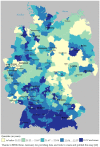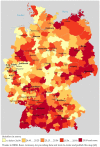Social Determinants of Remaining Life Expectancy at Age 60: A District-Level Analysis in Germany
- PMID: 35162553
- PMCID: PMC8835464
- DOI: 10.3390/ijerph19031530
Social Determinants of Remaining Life Expectancy at Age 60: A District-Level Analysis in Germany
Abstract
Remaining life expectancy at age 60 (in short: RLE) is an important indicator of the health status of a population's elders. Until now, RLE has not been thoroughly investigated at the district level in Germany. In this study we analyzed, based on recent publicly available data (2015-2017), and for men and women separately, how large the RLE differences were in Germany across the 401 districts. Furthermore, we examined a wide range of potential social determinants in terms of their bivariate and multivariate (i.e., partial) impact on men's and women's RLE. Men's district-level RLE ranged between 19.89 and 24.32 years, women's district-level RLE between 23.67 and 27.16 years. The best single predictor both for men's and women's RLE at district level was 'proportion of employees with academic degree' with standardized partial regression coefficients of 0.42 (men) and 0.51 (women). Second and third in rank were classic economic predictors, such as 'household income' (men), 'proportion of elder with financial elder support' (women), and 'unemployment' (men and women). Indicators expressing the availability of medical services and staffing levels of nursing homes and services had at best a marginal partial impact. This study contributes to the growing body of evidence that a population's educational level is a decisive determinant of population health resp. life expectancy in contemporary industrialized societies.
Keywords: health inequity; inequalities in health; life expectancy; life expectancy at older age; population health; social determinants of health.
Conflict of interest statement
The authors declare no conflict of interest.
Figures
Similar articles
-
Lifestyle risk factors and residual life expectancy at age 40: a German cohort study.BMC Med. 2014 Apr 7;12:59. doi: 10.1186/1741-7015-12-59. BMC Med. 2014. PMID: 24708705 Free PMC article.
-
District-Level Life Expectancy in Germany.Dtsch Arztebl Int. 2020 Jul 20;117(29-30):493-499. doi: 10.3238/arztebl.2020.0493. Dtsch Arztebl Int. 2020. PMID: 33087229 Free PMC article.
-
Is life expectancy higher in countries and territories with publicly funded health care? Global analysis of health care access and the social determinants of health.J Glob Health. 2022 Nov 12;12:04091. doi: 10.7189/jogh.12.04091. J Glob Health. 2022. PMID: 36370409 Free PMC article.
-
Changing factors and changing needs in women's health care.Nurs Clin North Am. 1986 Mar;21(1):111-23. Nurs Clin North Am. 1986. PMID: 3513129 Review.
-
[The study of health in men from a gender perspective: where we come from, where are we going].Salud Colect. 2020 Apr 24;16:e2246. doi: 10.18294/sc.2020.2246. Salud Colect. 2020. PMID: 32574451 Review. Spanish.
Cited by
-
Impact of Economic Freedom and Educational Attainment on Life Expectancy: Evidence From the New EU Member States.Front Public Health. 2022 Jun 30;10:907138. doi: 10.3389/fpubh.2022.907138. eCollection 2022. Front Public Health. 2022. PMID: 35844897 Free PMC article.
-
The long-term effect of social, educational, and health expenditures on indicators of life expectancy: an empirical analysis for the OECD countries.Front Public Health. 2024 Dec 18;12:1497794. doi: 10.3389/fpubh.2024.1497794. eCollection 2024. Front Public Health. 2024. PMID: 39744376 Free PMC article.
-
Quantifying the contribution of smoking to regional mortality disparities in Germany: a cross-sectional study.BMJ Open. 2022 Sep 30;12(9):e064249. doi: 10.1136/bmjopen-2022-064249. BMJ Open. 2022. PMID: 36180117 Free PMC article.
References
-
- Latzitis N., Sundmacher L., Busse R. [Regional Differences in Life Expectancy in Germany at County Levels and their Possible Determinants.] Regionale Unterschiede der Lebenserwartung in Deutschland auf Ebene der Kreise und kreisfreien Städte und deren möglichen Determinanten. Gesundheitswesen. 2011;73:217–228. doi: 10.1055/s-0030-1252035. - DOI - PubMed
Publication types
MeSH terms
LinkOut - more resources
Full Text Sources



